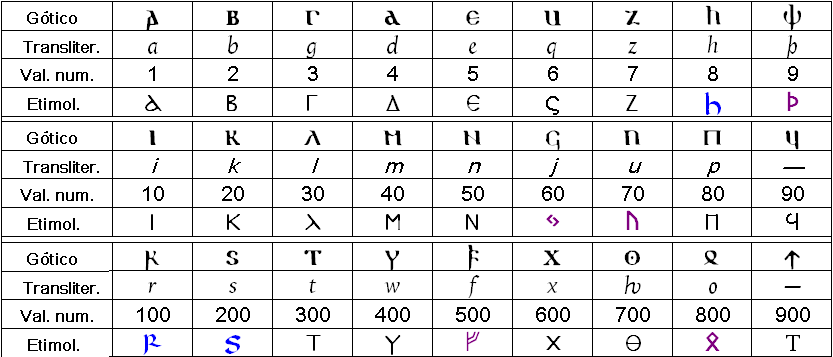Gothic alphabet
The Gothic alphabet is essentially an adaptation of the Greek alphabet in its uncial script.
It comes from the Ulfilan alphabet created by Bishop Ulfilas. It also contains three Latin uncial characters and five Germanic runes. Each letter has a numerical value and two of them have no other function. Transliteration in scientific and didactic works is done by increasing the Latin alphabet by two symbols by means of the ligature, ƕ (h+v) and the letter thorn , þ, borrowed from Old English. Ulfilas's notation was ambiguous: the same digraph ai could represent [ai], [ɛ] or [ɛ̄]. The transcription uses diacritics to alleviate reading difficulties.
Alphabet
Note: The lines represent (1st) the Gothic spelling, (2nd) the transliteration, (3rd) the numerical value, (4th) the etymology. This last line provides the original Greek letter whose resemblance to the Gothic letter is remarkable. The letters inherited from the Germanic runes are in purple, those that were taken from the Latin in blue. The proposed origins are only conjecture: there are several possibilities for the origin of certain letters, such as r, which could come from a rune.
Unicode
The Gothic alphabet was added to the Unicode Standard in March 2001 with the release of version 3.1.
The Unicode block for Gothic is U+10330– U+1034F in the supplementary multilingual plane. Since older software using UCS-2 (the predecessor to UTF-16) assumes that all Unicode code points can be expressed as 16-bit numbers (U+FFFF or less, the basic multilingual plane), problems can be encountered. when using the Gothic Unicode range and others outside of the basic multilingual plane.
| Gothic Official Unicode Consortium code chart (PDF) | ||||||||||||||||
| 0 | 1 | 2 | 3 | 4 | 5 | 6 | 7 | 8 | 9 | A | B | C | D | E | F | |
| U+1033x | ||||||||||||||||
| U+1034x | ||||||||||||||||
Notes
| ||||||||||||||||
Contenido relacionado
The great Dictator
Samaria
Maximilien Robespierre
